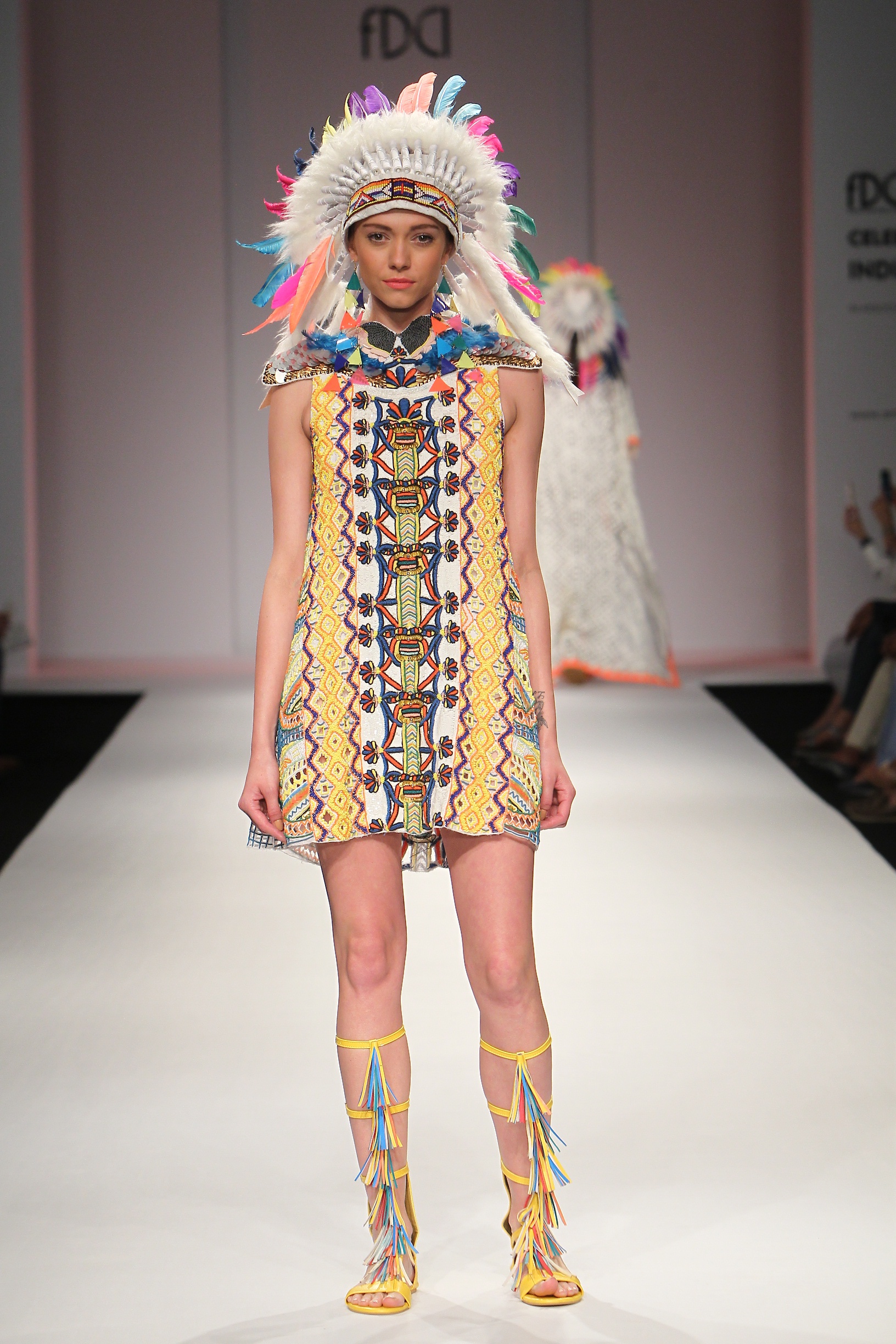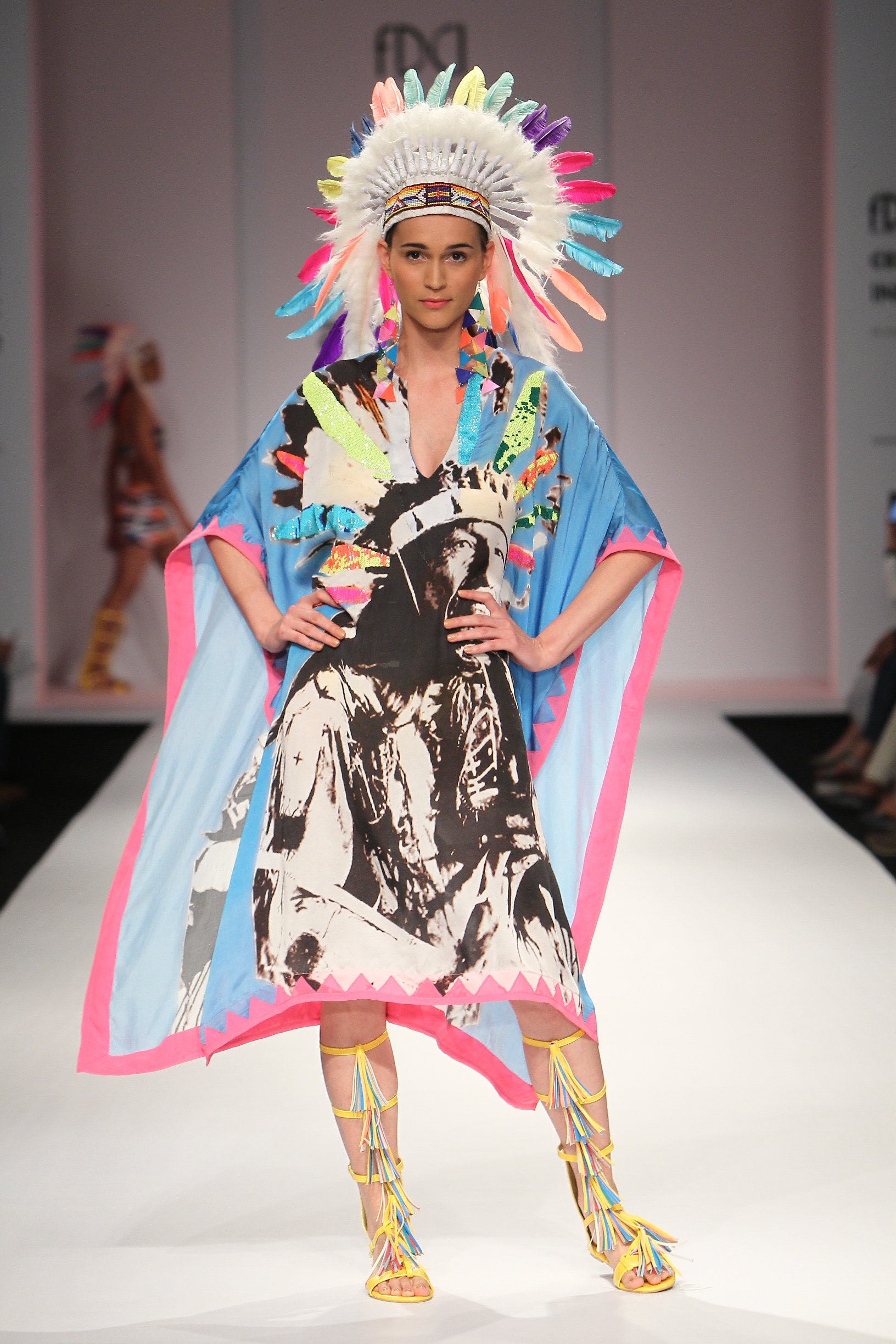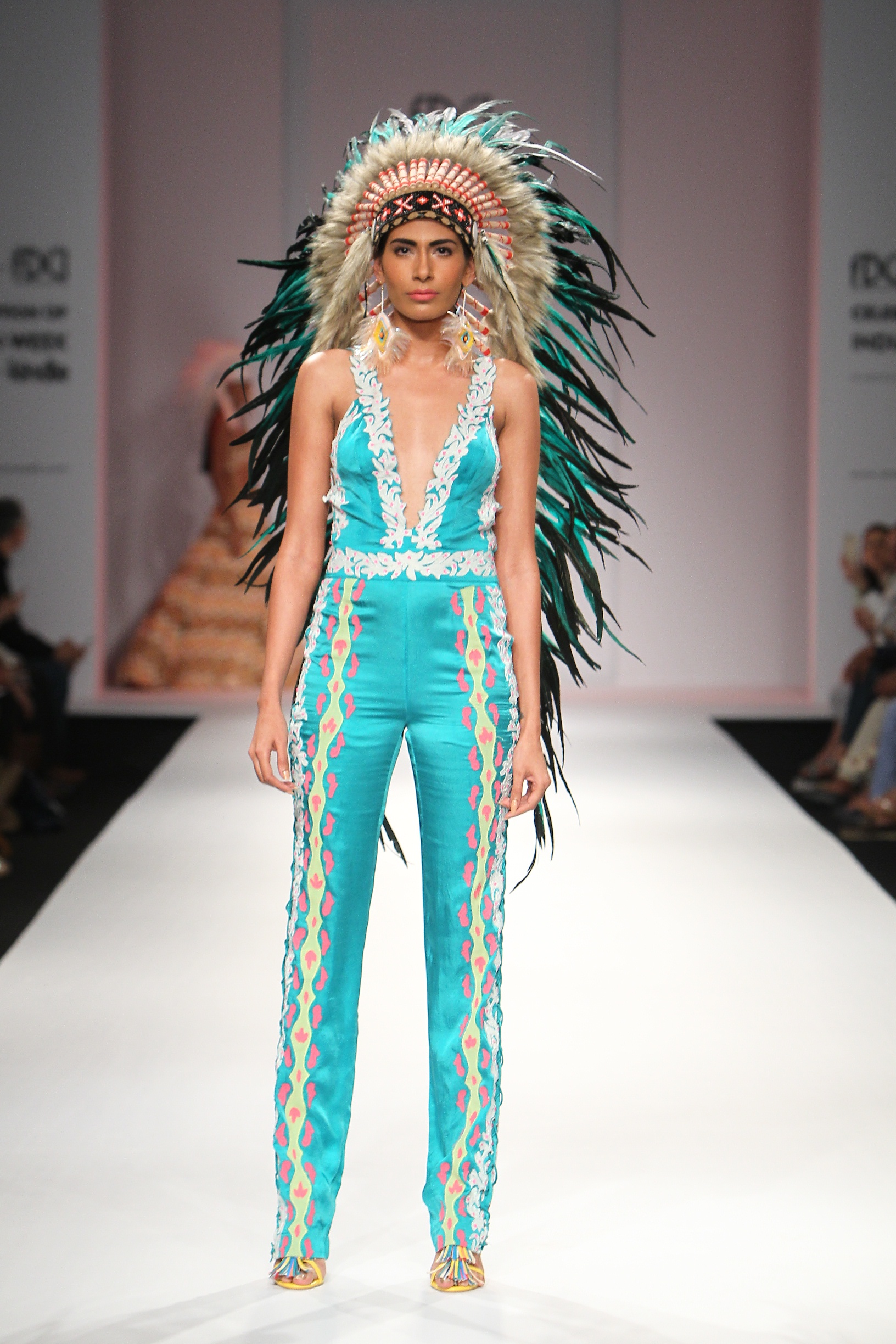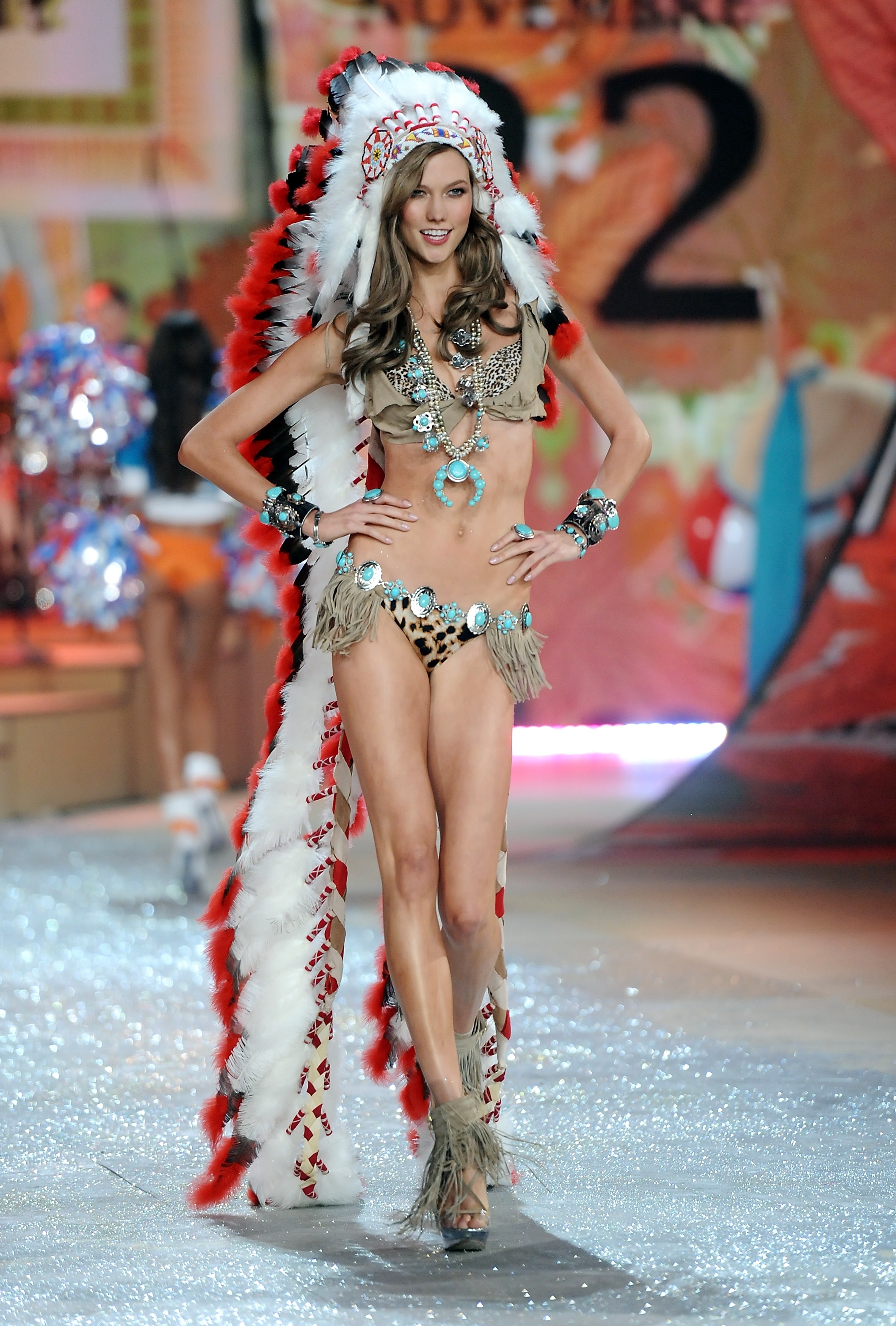Day Four of Amazon India Fashion Week saw Pia Pauro’s ‘Riders of the Storm’ collection which drew inspiration from the savannah, Navajo Indians, and the Burning Man Festival. And yes, the collection is named after The Doors’ song.
If you couldn’t tell with the massively culturally appropriative war bonnet headdresses, Pauro drew heavily from Native American inspirations, as evidenced by the horse motifs, triangular cuts, and tipi appliques.
Cultural appropriation is the adoption of items of significant cultural value by people outside the culture in question for the express purpose of rebranding or reusing the item for a different purpose than originally intended.
For instance, earlier this year, many Hindu Indians were vocally against a New York chocolate shop selling edible chocolate Ganesh statuettes. Ganesh, for those upset by this product, is for worshipping in temples and in home shrines not for ‘casual’ consumption.
The fundamental issue with cultural appropriation is that it is a vehicle for racism. Often by commercializing on a culture, such as with the selling of bindis for profit in stores like Urban Outfitters, the people who created the culture (along with the culture’s nuances) get erased. The item is divorced from its original meaning for the sake of commodification.
In addition, the meaning of the item is vastly perverted. In the case of the war bonnet, only men of specific tribes are supposed to wear the headdress once they reach a certain age, have proven themselves worthy in certain ways, and are deemed fit to do so by the tribe. There are some exceptions to this as women in some tribes wear them and they can be gifted to people who are considered ‘honorary’ tribe members. But it is never meant for some drunk college kid to dance around in it to Muse. It’s as disrespectful as an Om tattoo on somebody’s foot.
You may be asking yourself why any of this matters or you may be shaking your head and saying that cultural exchange is key to progress. The issue is that cultural appropriation is simply a symptom of racism. It embodies all the disrespect somebody has for cultures that are not their own.
Those wearing items that have been appropriated often don’t know the meaning of the item, it’s history, or it’s purpose. They view it all as fashion available for purchase. It’s a form of neo-colonialism. It does not occur out of respect for a culture – it’s about the need to make it a product and to own it.
In recent years, with the return of music festivals, we have been seeing cultural items popping up frequently in mainstream fashion. In response, minority groups have begun to voice their frustration on social media platforms, and the conversation about cultural appropriation has been gaining steam.
People shamelessly don Native American war bonnets, Indian bindis, mehndi, and Roma fashion (will touting ‘gypsy’ around like it’s a genre rather than a slur) for what has become known as ‘festival fashion.’ Pauro’s collection is only another episode in this chapter.
To be honest, there are a lot of issues with the collection. Pauro’s interesting use of colors and laser cuts are diminished by her weird obsession with creating a collection that uses Native imagery in bizarre ways.
Like below. What even?
It’s as though Pauro wants to make it very clear with the headdresses and imagery that she is paying homage to Native art and cultures. But all it does is show she did not do enough research. It’s as though she looked under the ‘American Indian’ tag on Pinterest and just used all the Halloween ‘squaw’ costumes and Southwestern trinket shop pictures to educate herself.
Some of the other looks (again trying to ignore that flamboyant rainbow feathered thing) are neutral at best. They wouldn’t be especially interesting without the headdress. Pauro’s gimmick is masking.
Pauro muddles up her inspirations and homogenizes all of the Native cultures she draws from. In one press releases she talks about the Navajos, Arizona, and the Rocky Mountains
while in another she is speaks about the savannah and Burning Man inspiring her work. These are separate concepts. I think, if anything, it’s festival fashion and Burning Man that is the driving force behind this collection.
There is no real link to Navajo or other Native cultures besides obvious imagery. Even that she probably just found online in some ‘free-spirited’ pinterest users boards.
There is absolutely no need for the headdresses or for the cheesy references to Native Americans in this collection. Some of the pieces, like the sari below, are gorgeous in their own right.
She seems capable of taking subtle pointers from Native patterns and textiles. The fringed edge on the pallu is an interesting touch that I would have liked to talk about under different circumstances.
There is a way to do inspiration, and this really isn’t it. Pauro could have taken direction from colors, textiles, imagery, and history without brazenly misusing items of Native significance. Her use of color and her twist on traditional outfits is interesting enough without the cultural appropriation.
It’s important to remember that just because fashion is a form of art does not mean it’s above criticism or social politics. Art is not created in a vacuum and it exists as a form of social commentary. It is reflective of the society if comes from. Therefore if we can get upset about the goddess Lakshmi on a swimsuit or Dolce & Gabbana sending racist black figurine earrings down the runway, we can and should be upset about Pauro’s collection and similar items.
A few years ago, Victoria’s Secret put a war bonnet on one of their models and received major backlash. Soon after it had to issue an apology. There is precedent for cultural appropriation occurring in fashion just as their is precedent for dissent, reflection, and progress.
Given that Pauro is an Indian designer, her understanding of the delicate political correctness we try to maintain in America may be lacking. At the same time, her collection takes major direction from so called ‘festival fashion,’ which often includes the rampant cultural appropriation of Native, Indian, and Roma fashion.
So really the whole thing is a wash.
The moral of the story we need to be adamant and vocal in our opinions that minority groups should not be treated like themes and commodities. We should not be giving fashion a ‘get out of jail free card’ just because it’s art. And as a minority group ourselves we should see our own maltreatment of others and prevent it.












